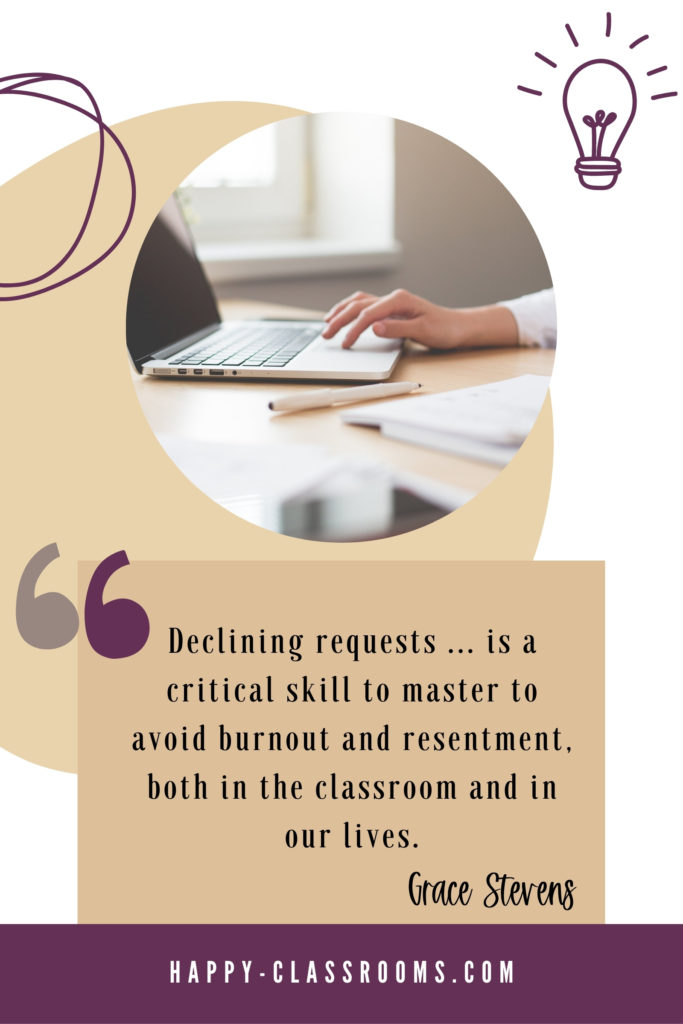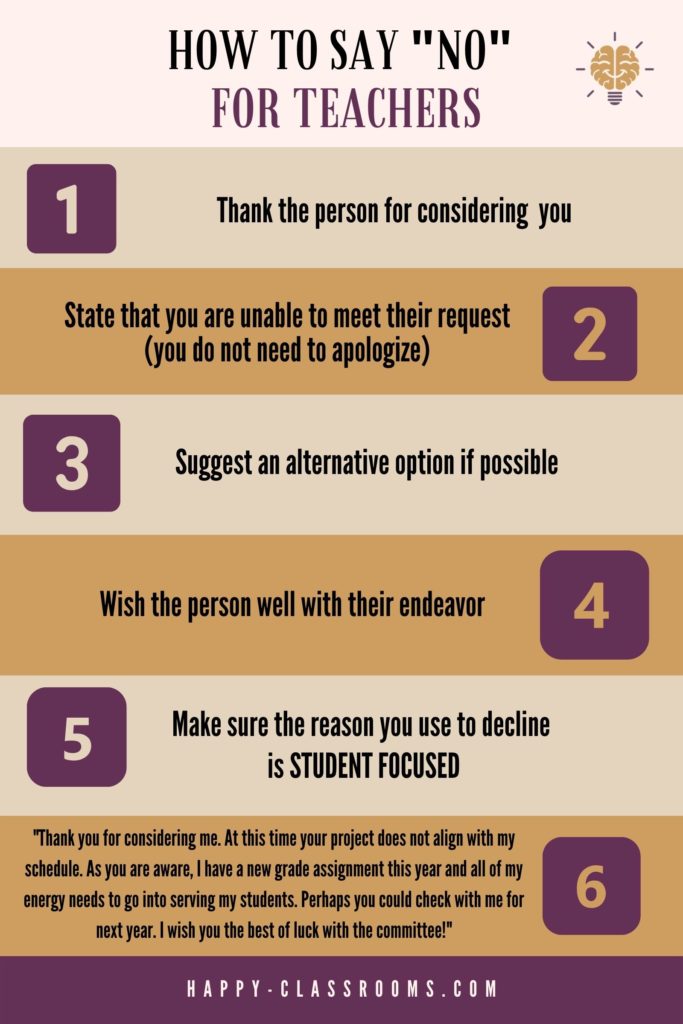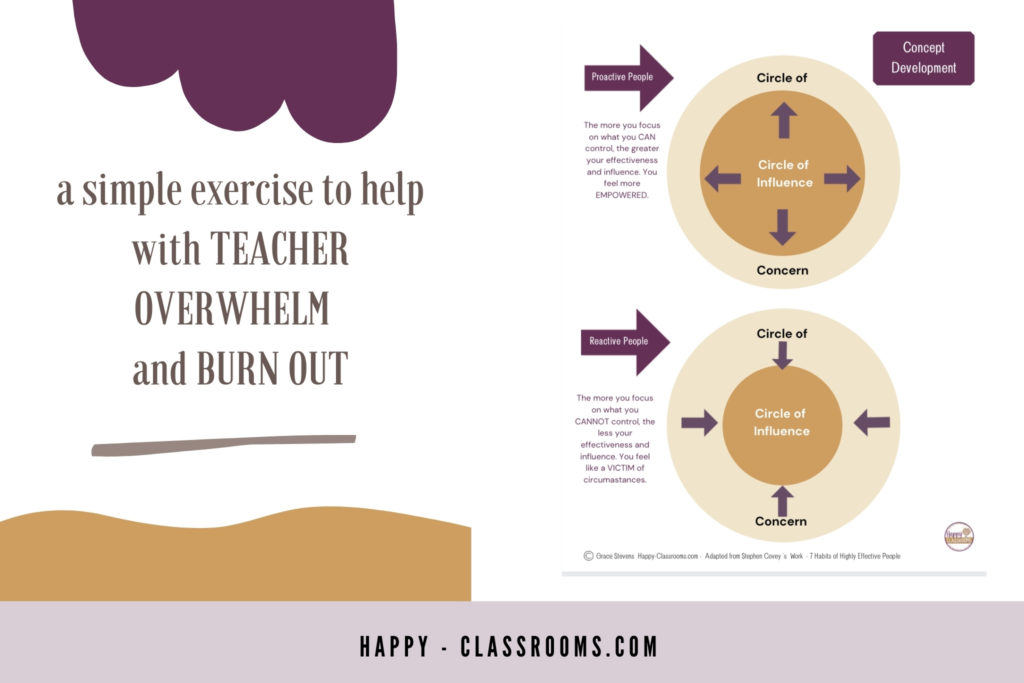If you’ve found your way to this blog, you are well aware that one of the biggest stressors for teachers is the overwhelming amount of tasks and responsibilities that we constantly have piled on us. In addition to creating stress, these additional responsibilities cause frustration as many of them have nothing to do with teaching children (the job we signed up for).
Teacher job stress is at an all-time high. Even before Covid and Tik Tok challenges crashed into our world, I have experienced firsthand the demands placed on teachers significantly increase over the two decades that I have spent in the classroom. Regardless of the grade or the geographic area where we teach, it seems there simply is not enough time in the contracted day to achieve even half is what is demanded of us. But you already know this. So what’s the solution?
The Top Strategy To Help You Manage Teacher Job Stress – Setting Boundaries on Your Time
Setting Boundaries. Saying “No.” Declining Graciously. Holding Ground. Two words that seem so simple but are so difficult to do.
I know there isn’t a teacher out there who doesn’t agree that they would actually be more relaxed, positive, and more focused on student learning outcomes if they had “less” of the administrative tasks to attend to. Setting boundaries takes courage and practice, but this roadmap can help.
Wait… before I dive in with specific strategies, I feel for your overwhelmed teacher soul. I invite you to a FREE PDF copy of my best-selling Positive Mindset Habits for Teachers Journal. It contains fun research-based prompts to help you have a more positive teaching experience. HERE’S THE LINK It’s not a magic cure, but it definitely helps.
Tip 1: Ditch the Martyr Mindset
Time for some tough love. As a collective culture, teachers are not helping their own cause regarding setting themselves up for success. We tend to be fixers and pleasers in general. Many schools have a toxic culture where teachers who put in the most hours or sign up for the most adjunct duties are viewed as more dedicated, professional, and capable. Every time we share anecdotes and memes about how exhausted we are, how many hours we are working, how we are “crawling towards the finish line” whether it be the end of the week or the end of the trimester, we contribute to this negative collective consciousness.
Here’s the hard truth. There is no prize for being the first car in the parking lot in the morning and the lost car at night. Many teachers “complain/brag” about how many hours they work and wear their exhaustion like a badge of honor. Some are strangely competitive about how little they have slept and how much coffee they need to consume to get through their day.
While I am certainly not advocating that anybody neglect their professional duties, working more hours does not necessarily make you a better teacher. On the contrary, it makes for a tired, resentful, overwhelming, reactive experience. Exhausted teachers cannot bring the best of themselves to their students.

I am a firm believer that in the classroom, our energy teaches more than our lesson plans. We become better teachers when we are rested, patient, proactive, and have enough energy to engage in some fun. Student outcomes reflect that. We are kidding ourselves if we think students don’t notice we are burned out.
Not only is it toxic to glamorize how exhausted we are, but it is also harmful to be judgmental towards staff members who do not work beyond their contracted hours.
I am not denying that it is very frustrating to work with team members who do not contribute equally. But in my experience, there are very few “slacker” teachers. If a teammate is not pulling their weight, the right thing to do is to address this with them, or ultimately our administrator. Do not assume that the teacher who leaves at a reasonable hour every day is contributing less. Most likely have responsibilities with their own family that makes them need to leave school at a particular hour. Maybe they are picking up their work again when they get home or perhaps they are a Master Jedi at productivity. If the latter is the case, we may need to seek strategies from them and make them our new teacher bestie.
Tip 2: Learn How to Manage Expectation for Teachers
We teach people how to treat us by what we tolerate. I don’t remember who initially said that, but most of us need to learn for ourselves. It took me a few painful relationships and overwhelming school years to get on board.
Many of us are exhausted by being at the “beck and call” of parents who contact us at all hours and expect immediate responses. While parent communication apps that end up on our phones, such as Class Dojo and Parent Square are beneficial, they do mean that the solution to being constantly bombarded is not as easy as the advice, “don’t check your email from home.”

Here are some tips to Setting Boundaries with Parents:
- Set up clear expectations for communication during your “Back to School” night. Let parents know when you are available, how you prefer to communicate, and a reasonable amount of time they should expect to get a response. Most schools have a 24-hour turnaround policy on email questions. It is perfectly acceptable to respond within that timeframe to let a parent know you are working on their issue and need more time to get back to them.
2. Consider setting up weekly office hours. I usually opt to work “late” just one evening a week, getting all of my grades input and my lesson plans set for the following week. I make it Wednesday, and my family plans accordingly. I know this is not possible for many of you, and it certainly wasn’t an option for me when my children were younger. However, as I will be on campus later anyway, I let parents know that if they need a meeting after hours, it will need to be virtual and on a Wednesday. Even though this makes for a long day on Wednesday, it means I only work late one day a week, by choice.
3. Leverage technology. While parent communication apps are beneficial, make sure to set up “quiet hours” so that you don’t receive notifications when a parent leaves a message.
4. Assume the best intentions. Just because a parent sends an email or a message at 9 PM, doesn’t necessarily mean that they expect a response at that time. Parents are busy too. They just might be sending the message at that time because it was the first chance they’ve had, and they want to take care of it while it’s on their mind. Creating a dramatic narrative in our head about how a parent doesn’t respect us and is expecting an immediate answer may not be true and certainly isn’t helpful.
5. Don’t set a precedent. Beware the slippery slope of responding to one email at 8 PM or accommodating a parent who shows up at your door 5 minutes before or after class and expects to have a meeting with you. It sets a dangerous precedent, not only with that parent but with others who observe or hear about it (and magically, they do). We are educational professionals. Many of us have almost as much post-graduate education and units as lawyers or medical professionals. No one would think it’s appropriate to stroll into a lawyer’s office when it was “convenient for them,” demanding immediate attention. If it’s a true crisis, then refer the parent to the administrator. Otherwise, they need to wait for an appointment.
6. Be polite, but firm. Before school, it should be obvious that you need to set up for the day and teach. After school, most likely, you have a meeting or some other obligation that needs to take precedent. Note, your precious planning time is an obligation to yourself and your students. You shouldn’t make a habit of giving it up based on a parent’s whim because they consider your confiscating their child’s fidget spinner a violation of their rights.

Setting Boundaries with Administrators:
This area can be a little trickier. Some of the strategies are going to be the same. For example, don’t set precedents. If your administrator emails you or sends you a message outside of regular work hours, do your best not to answer until you are back at school the following day.
Also, don’t assume that they are even expecting an immediate response. Administrators are just as busy as teachers, and they may simply be emailing you when they finally found the time to get around to the issue or request that they are making of you.
Tip 3: Learn to Say No Without Guilt
Our most significant opportunity to reduce overwhelm by setting boundaries with our administrator is to learn how to decline requests for additional duties confidently and without guilt. Declining requests in general often takes us right out of our comfort zone, but it is a critical skill to master to avoid burnout and resentment, both inside the classroom and in our lives.
Here are some helpful tips.
Be proactive about volunteering for committees or duties that interest you.
It’s unlikely that there are schools out there where teachers are not required to accept additional responsibilities outside of the contracted school day. While some schools merely “highly encourage” it, many districts require teachers to accept a certain number of “adjunct” duties every year as part of that contract. Beyond stipend positions, where teachers get paid a small stipend to coach sports, supervise student council, or coordinate academic clubs, there are many other unpaid areas that need to be staffed with teachers. These include committees: curriculum committees, safety committees, new hire committees, school site council, the list goes on and on. This also includes social activities and clubs for students. Many teachers feel “guilted into” accepting requests because they don’t want students to go without enrichment activities. Getting “voluntold” to be on committees is also one of the big stressors for teachers.
Here’s How I Dealt with Additional Duties
IMPORTANT: before accepting extra duties, consider your interests. I put in way more than the contractually required “extra” hours for many years because I genuinely loved the things I signed up for.
Because I worked for a small school without a dedicated science teacher and I love all things science, I focused on science-related activities. I organized up a Family Space Night with local astronomers. On my own time, I became certified to run the county’s portable planetarium and took pride in taking many groups of students and parents through it both during school time and after school. I put on a Science Fair and a Family Science Night. My own children came to love these activities and participated with me as they grew, and so the extra work, while tiring, was joyful and fulfilling.
I was also head of the Student Success Team meetings for five years, even though it was our district policy that this position did not come with a stipend, and all meetings had to be held after school. Again, it was a lot of work, but I found it rewarding because I could directly observe the positive impact on the student as they grew through the years at the school. The work felt meaningful and important as it directly impacted student outcomes. Compare that to being on a committee that “unpacked the new NGSS standards,” organized a school fundraiser and auction, or a safety committee that ran simulations for how to deal with bomb threats and active shooters. These are all things I reluctantly agreed to and lived to regret.
You get the idea. One set of duties filled me up, the other depleted me. So try and be strategic. Fill up your quota with activities that you will find meaningful before you are roped into the ones that will crush your soul. I know that sounds dramatic, but you understand all too well how stressful sitting on a committee that you have no interest in is when all you can do is think about the other hundreds of things you need to attend to.
Buy Yourself Some Time. We often end up saying “yes” to commitments we have no desire to participate in simply because the request took us by surprise, and we didn’t have time to “think of an excuse.” Get into the habit of buying yourself some time to consider the request and its impact. My well-rehearsed response is always, “Thanks for asking. Let me give it some thought and get back to you.” This serves two functions. First, you will have time to actually weigh up the pros and cons of accepting. Also, let’s be honest, it is WAY easier to decline a request in writing than it is to say no to someone’s face. Also, it never hurts to have a “paper trail” when the request comes from a parent or an administrator.
Have a “script” ready to go. Note: it need not include the word “sorry.” It helps to have a standard “script” prepared that you can reply with. I usually follow the formula:
- Thank the person for thinking of you
- Politely decline (again, no need to apologize)
- Suggest an alternative option if you can
- Wish the person well with their endeavor.
- It might look something like this:
“Thank you so much for thinking of me. The project/committee/task you are requesting does not align with my schedule and priorities. Perhaps you might consider … (suggest a reasonable alternative or suggest they check back with you next quarter/year to see if your priorities). I wish you every success with your endeavor/project.”
Make sure to cite STUDENT CENTERED reasons for your decline. This is key when declining requests from your administrator. You will be poorly looked upon if you decline a request based on your preferences or personal schedule. Be sure to tie the reason for your request back to meeting student needs. Meeting student needs is your primary function, after all. It might look something like this:
“Thank you for thinking of me. As you are aware, I have a challenging group of students this year ( a new grade assignment, a new curriculum, a new teammate to get up to speed) that is taking up much of my extracurricular time. I am reluctant to take on any additional duties that will take me away from my primary focus of meeting the needs of my students and improving student outcomes. Maybe things will be better next trimester. Thanks for understanding.” Again, offer another solution if you can think of one. “Another solution” does not mean naming another teacher. That just smacks of “passing the buck.”

Recap: Professional Goal for Teachers – Less is More. Get Comfortable Setting Boundaries is the Key
I can never say it enough – your energy teaches more than your lesson plans. The best thing you can do for your students is show up for them every day with energy, passion, and patience. The only way to accomplish this when there is an ever-increasing push to add more and more onto our teacher plates is to set boundaries on our time.
Here’s what helps me. I recognize that every “no” I say means I am saying “yes” to something else.
Time and energy are finite and our most precious resources. While it can be uncomfortable to decline a request, it’s better to feel uncomfortable for a few minutes than tired and resentful for the rest of the year. When we say “yes” to something we don’t want to do, we are saying “no” to other things in our life that can provide us with joy, relaxation, and balance.
As well as being one of the most significant stressors of teachers, being overwhelmed takes a toll on our family and personal relationships. I came to the point in my teaching career where I recognized at some point I would be letting someone down and feeling guilty. There just weren’t enough hours in the day to accept all the responsibilities and requests. I decided that saying “yes” to my family, health, and well-being was more important than saying yes to a parent club or administrator who had their own agenda and may well be gone the following year.
Bonus Strategy for Handling Teacher Job Stress
Setting boundaries is a big topic, and learning to graciously decline additional duties is just one area. Stressors for teachers take many forms. Stay tuned! In future blog posts, I will be addressing setting boundaries on your space as a teacher and, most importantly, how to set boundaries on your energy.
In the meantime, focusing on what you can control is a crucial step towards feeling empowered and less overwhelmed. A simple tool to help with this is completing a Circle of Concern/Circle of Influence exercise. You can grab a copy at this link. Extra credit – teach your students the same strategy! There are versions of the activity complete with lesson plans available in my TpT store for younger, middle, and high school students. I really think it will help reduce stress.

For more information on this topic, check out this excellent article about the top 10 stressors for teachers and creating boundaries:
https://medium.com/invisible-illness/the-top-ten-stressors-for-teachers-4195490f70e7
http://kappanonline.org/teacher-stress-balancing-demands-resources-mccarthy/
https://www.edutopia.org/article/necessity-boundaries
Finally, help a fellow teacher out! What is the best decision to say “no” that you’ve made in your teaching career, and how did it work out for you? Drop it in the comments below and help others manage their top stressors for teachers.


